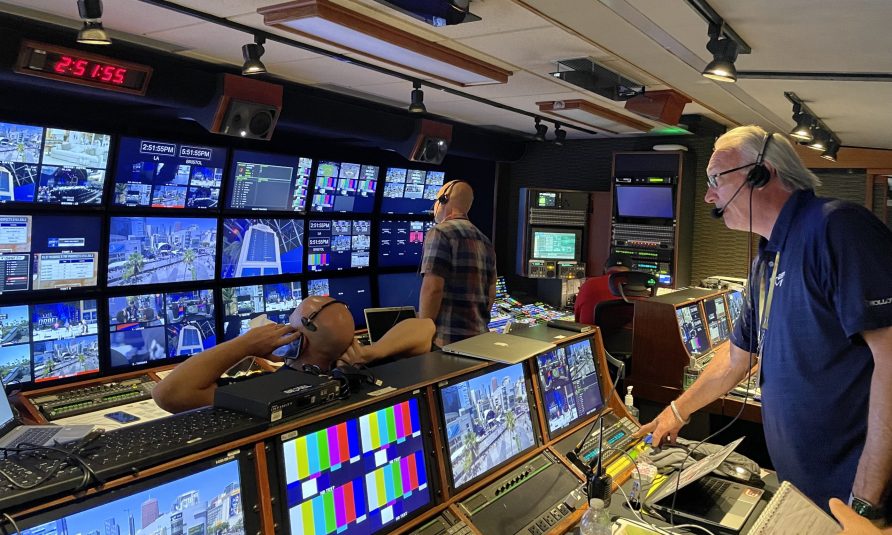Live From MLB All-Star 2022: ESPN Pumps Up Onsite Home Run Derby Production at Dodger Stadium
The network also produced Rounds 1 and 2 of the 2022 MLB Draft on July 17
Story Highlights
After lighting up the Rocky Mountains in Denver last year, the traveling spectacle that is the MLB Home Run Derby makes a stop in Los Angeles. ESPN will televise the 2022 iteration with a renewed sense of documenting the up-tempo speed of the event, constant communication between the production and operations teams, and permanent connectivity installed at Dodger Stadium through collaboration with the other U.S.-based broadcasters.
“The battle that comes with producing the MLB Home Run Derby is managing the electric pace [of the event] while trying to do new and innovative things at the same time,” says Phil Orlins, VP, production, ESPN. “We’ll be pushing our technology extremely hard this year, but it comes challenging when balls are being hit every four or five seconds.”
Preparation and Planning: Crew Meticulously Plots This Year’s Event
Months before any of the eight competitors steps into the batter’s box, ESPN took the time to methodically plan out the event from beginning to end. The heaviest lift comes with understanding the multiple linear and digital activations attached to this production. With another year of producing dedicated coverage of the 2022 MLB Draft as well, the logistical responsibilities become harder and harder to complete. Luckily, Orlins and his production crew are backed up by a stellar operations team that sets up a surefire foundation, including Remote Operations Specialist Kevin Cleary, Remote Operations Manager Paul Horrell, and Project Manager Cindy Pennington.
“This is always a large marquee event with a lot of separate productions,” says Horrell . “There are similarities year after year, but there are also new technologies and hybrid workflows to address.”
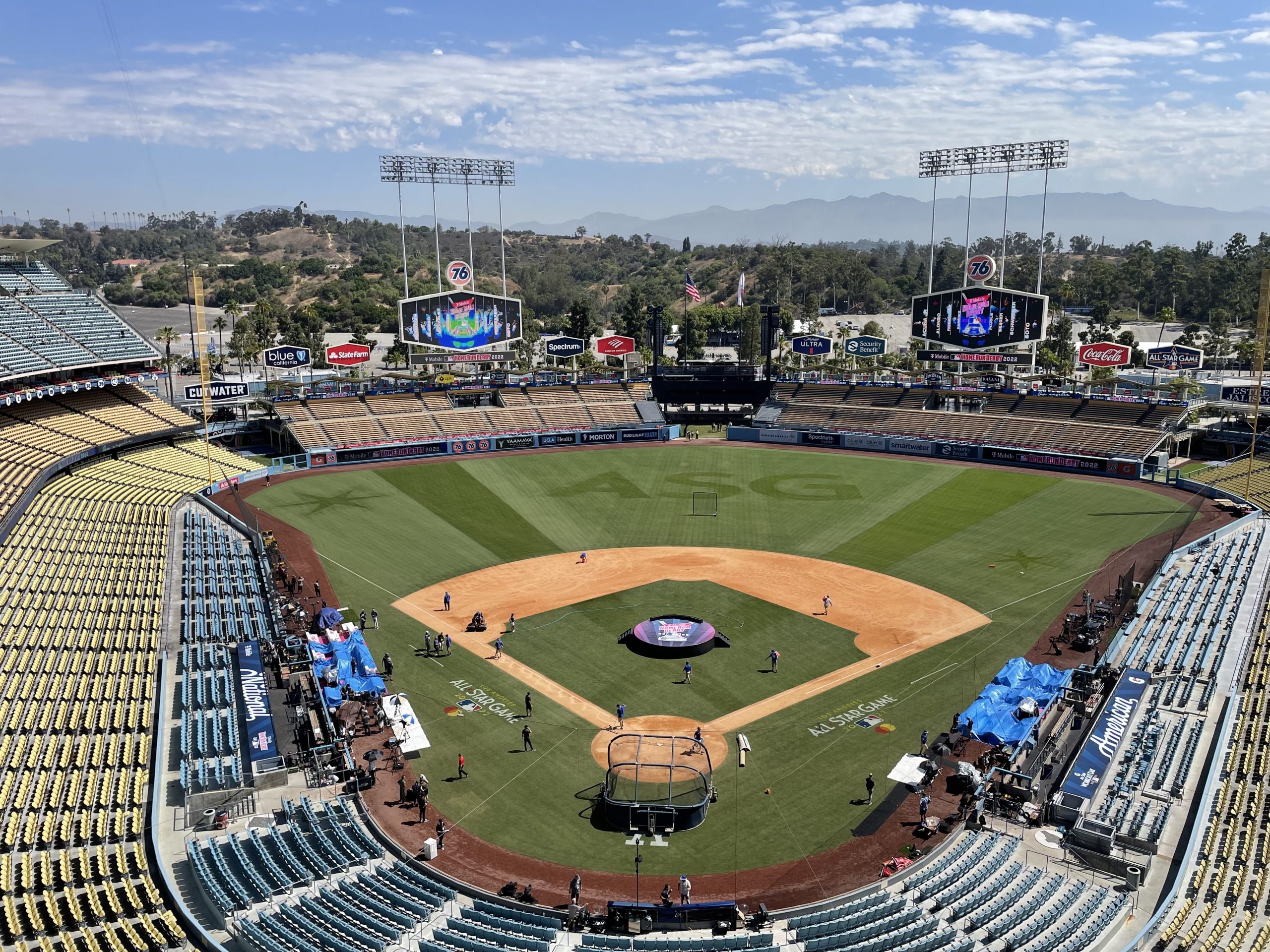
Dodger Stadium will host the 2022 MLB Home Run Derby on Monday, July 18 at 8 p.m. ET.
With the many aspects to be ironed out, the planning stage becomes critical. Despite the numerous obstacles, the ops team is able to rely not only on each other but on working partnerships with the league and fellow broadcasters.
“The collaboration and cooperation with MLB and the other broadcast partners has always been tremendous,” says Horrell. “I think that really speaks to the level of agility and problem-solving to make this all happen.”
Intricate Dance: Production, Ops Teams Match Fast Tempo of the Derby
Unlike any other event in Major League Baseball, the MLB Home Run Derby departs from traditional norms of the game and offers unparalleled excitement. With a format introduced for the 2015 MLB Home Run Derby in Cincinnati’s Great American Ball Park, Monday night’s Derby will bring the energy and chaos for the seventh year. As fans in the stands and fans watching from home enjoy the efforts of some of the best power hitters in the sport, ESPN’s personnel in the compound have the tough task of capturing every swing and home run to document the story. The Statcast version on ESPN2 — with play-by-play commentator Jason Benetti, analyst Jessica Mendoza, and MLB Statcast analyst Mike Petriello — poses different challenges with its heavy emphasis on graphics. The frenetic nature prevents the team at the front bench from bouncing around to different camera angles, and Orlins laments the constraints the production is under.
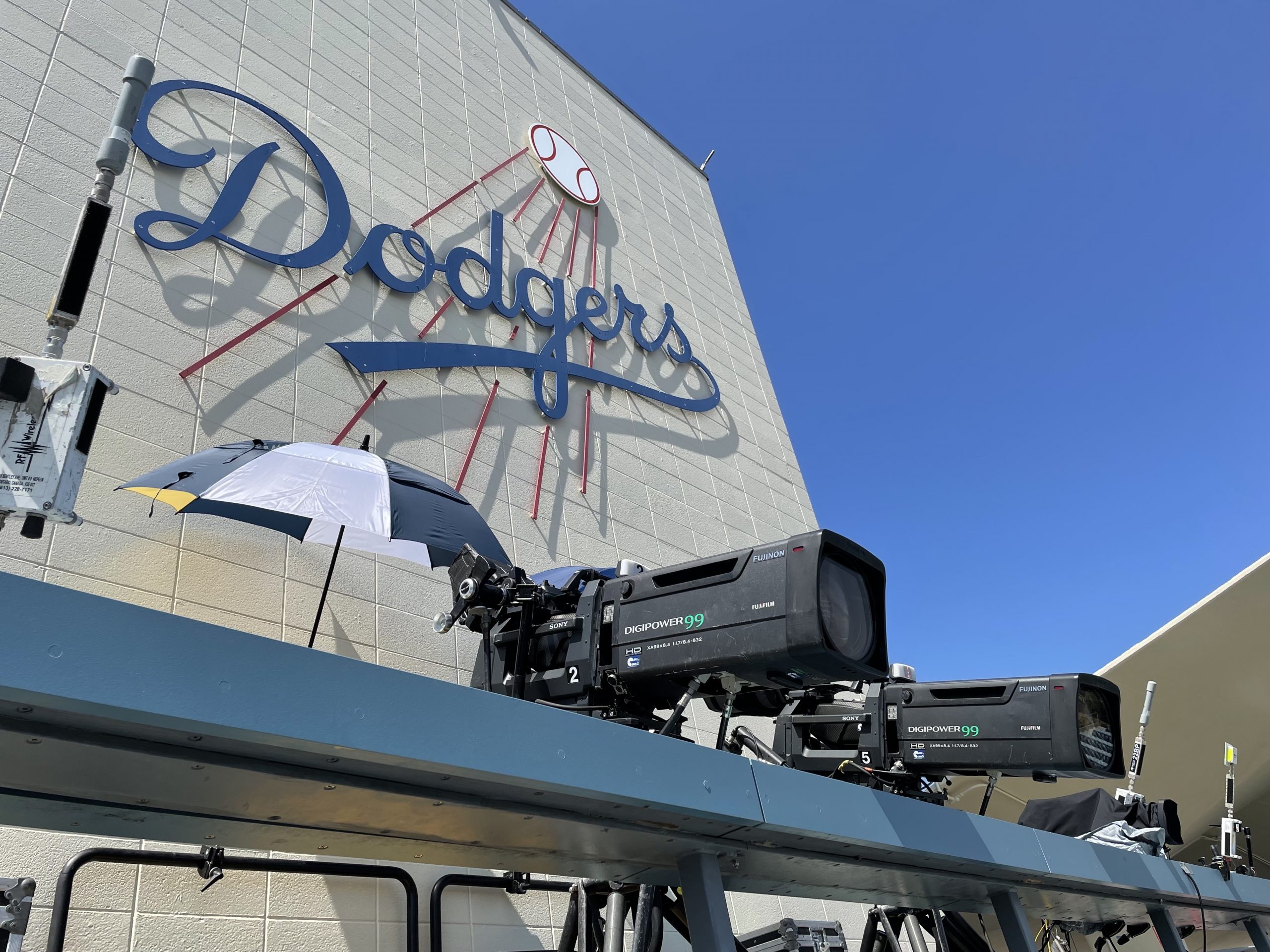
The network moved up their high home cameras to show the full flight of the baseball.
“If I wasn’t limited by the size of the screen,” he says, “I’d like to show three things happening at once: I would want to find a way to show the pitcher and hitter on one part of the screen, multiple balls flying in the middle part of the screen, and a graphical presentation on a third part of the screen. It would most likely be overwhelming to me as a viewer, but that’s what I’d love to be able to do.”
In the real world, the main telecast — with play-by-play commentator Karl Ravech, analyst Eduardo Perez, and reporters Buster Olney and Marly Rivera — will feature this simple setup: the pitcher and hitter on one piece of the screen and balls flying over the fence on a larger portion of the screen, supplemented by 3D animations like tracking and virtual reality between foul balls and the conclusion of a batter’s allotted time.
The operations team is on hand to resolve any production need. From its perspective, the biggest hurdle is overcoming the latency between the broadcast cameras and the overlay of virtual components.
“Much like what we do on a regular Sunday Night Baseball telecast, we have to adjust for this delay,” says Cleary. “The biggest lift is adding those elements into the show and making them look seamless.”
Making Dreams a Reality: Day 1 of 2022 MLB Draft Is Live From L.A. Live
Amateur athletes instantly turned into professional ballplayers during Day 1 of the 2022 MLB Draft on July 17. MLB Network shared five resources for its Draft coverage with ESPN, adding to the broadcaster’s five individual camera feeds at the Draft stage at L.A. Live.
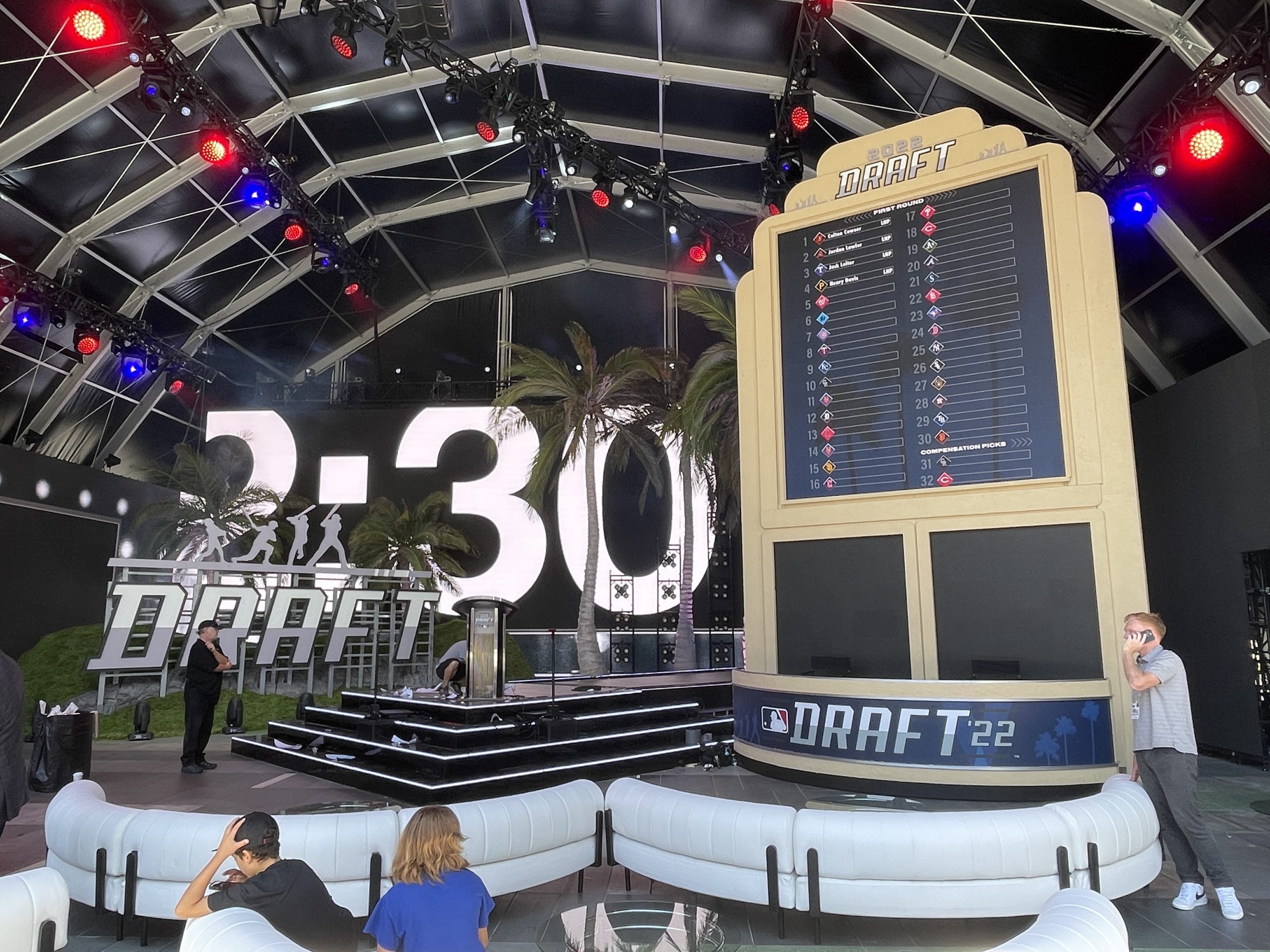
ESPN, along with MLB Network, hosted Day 1 of the 2022 MLB Draft from L.A. Live.
On the production side, Ravech hosted the event and was joined by analysts Kiley McDaniel, Kyle Peterson, Chris Burke, Jeff Passan, Perez, and Mendoza from the broadcaster’s studio in Downtown Los Angeles. On the operations side, the network housed its production staff in the Dodger Stadium compound as the show took place about 3 miles south near Crypto.com Arena.
“We did a REMI production into Game Creek Video’s Gridiron at the Draft location,” says Cleary. “We were able to split this mobile unit with MLB Network to take our feeds from there and produce it from Dodger Stadium.”
Difficult Balance: Onsite Workflows Mix With Handful of Remote Staffers
Originally, MLB All-Star was slated for Los Angeles in 2020. After the onset of the COVID-19 pandemic four months prior to the Midsummer Classic, Major League Baseball decided to postpone the festivities for the first time since 1945. Since then, the sports-video–production industry has changed dramatically, and the crew has had to learn new ways of getting their jobs done. Operationally, this includes managing onsite workflows while also deploying staffers working remotely. To keep the show on the rails and in order, Cleary emphasizes organization as the key to the network’s success.
“The real question [is knowing] who’s in the truck, who’s at home, and how we solidify the hybrid model that we’re evolving into,” he says. “Whether somebody’s sitting behind you or they’re in another city, it’s about figuring out how to make sure that the production doesn’t suffer.”
Ultimately, development of the desired production environment is about making sure every crew member receives the materials necessary to fulfill their duties. And given that people operate differently in a post-pandemic world, the operations crew has to increase their coordination to ensure a smooth show.
“We have to see that our operators are getting all of the correct feeds,” explains Cleary. “You’re constantly chasing what somebody’s needs are as well as servicing and supporting the [overall] production.”
Here to Stay: Permanent Connectivity Infrastructure Installed at Dodger Stadium
To streamline productions for all parties in Los Angeles, the three main broadcasters on the scene — ESPN, Fox Sports, and MLB Network — worked together to establish reliable connectivity at 60-year-old Dodger Stadium. Instead of laying down temporary fiber only to take it out after Tuesday’s All-Star Game, the trio decided to install permanent broadcast fiber at the venue.
Benefiting from this endeavor are the onsite mobile units parked in the television compound. The A and B units of NEP EN2 will drive the main linear production of the Home Run Derby; the A, B, and C units of NEP ND7 will produce the Statcast edition on ESPN2. This truck also produced Day 1 of the MLB Draft, along with a two-hour version of Baseball Tonight with host Kevin Connors and analysts Tim Kurkjian, Mendoza, Burke, Passan, Peterson, and Xavier Scruggs; and ESPN Deportes’ coverage of the Home Run Derby with play-by-play commentator Ernesto Jerez, analyst Luis Alfredo Alvarez, reporters Carolina Guillen and Monica Puig, and contributors Mauricio Pedroza, Herculez Gomez, and Katia Castorena.
The massive undertaking has been helped by ESPN’s multiple stops in Los Angeles for productions of Sunday Night Baseball. The connectivity will be used for the Thursday Night Baseball game between the San Francisco Giants and Los Angeles Dodgers on Thursday, July 21 at 7 p.m. ET.
“We’re here a lot of times during the regular season and postseason,” notes Cleary. “Having familiarity [with the ballpark] certainly does help leading up to these events. Between all of the different broadcasters, we have the ability to share feeds with each other.”
Event Filled With Fun: ESPN Aims To Serve the Greater Baseball Community
Fans can’t get enough of the crown jewel of MLB’s summer schedule, with a flurry of activities in a five-day span. The MLB Home Run Derby is a nice teaser for the fireworks expected in Tuesday’s MLB All-Star Game.
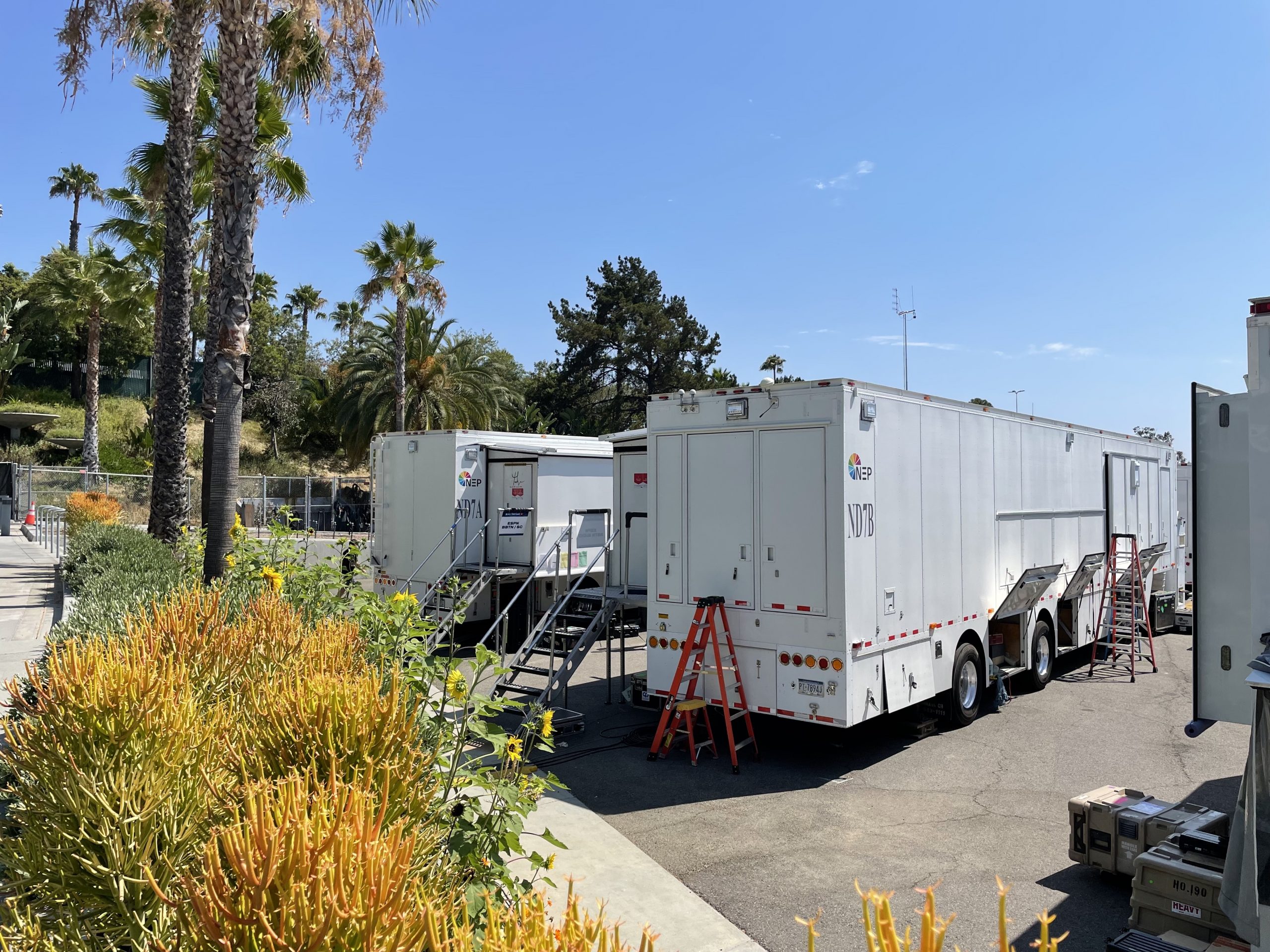
NEP ND7 and EN2 are at the heart of ESPN’s operations in the compound.
“I can’t say enough about our technical crew and remote-operations departments across the board,” says Horrell. “The support we receive has always been fantastic, and the production team’s commitment to expanding coverage and exploring new ideas creates the most exciting and complete viewer experience possible.”
Along with the intriguing technologies deployed behind the scenes, there is a full-circle moment that will be experienced by the network in Los Angeles. After waiting for two long years, the show has ascended to the greatest stage in Hollywood.
“Dodger Stadium is a phenomenal and iconic ballpark,” notes Cleary, “but it’s really about producing a fun event. Seeing the faces of both kids and adults in the crowd shows how much the fans are into it.”
Coverage of the 2022 MLB Home Run Derby begins at 7 p.m. ET on Monday, July 18 on ESPN, and the Statcast edition begins at 7:30 p.m. on ESPN2.
